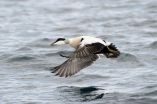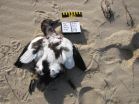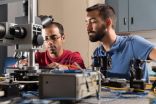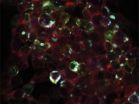(Press-News.org) ITHACA, N.Y. - Since 1998, hundreds and sometimes thousands of dead eider ducks have been washing up every year on Cape Cod's beaches in late summer or early fall, but the reasons behind these cyclic die-offs have remained a mystery.
A team of scientists from Cornell, Tufts University, University of Georgia, the U.S. Geological Survey and the U.S. Fish and Wildlife Service have pinned down one of the agents responsible: a pathogen they're calling Wellfleet Bay virus (WFBV). Their findings shed light on why eider ducks (also called common eiders) die on Cape Cod every year and offer hints about how the virus spreads.
The study, "Cyclic avian mass mortality in the northeastern United States is associated with a novel orthomyxovirus," will be published in the January issue of Journal of Virology.
Lead author Andrew Allison, a postdoctoral fellow at the Baker Institute for Animal Health in the College of Veterinary Medicine at Cornell University, identified and named the virus. WFBV is a new orthomyxovirus, Allison said, which places it in the same family as influenza viruses.
Julie Ellis, a research assistant professor at Tufts' Cummings School of Veterinary Medicine, is executive director of SEANET, the citizen-science organization that counted and collected dead eiders for the study. She says community members and visitors to the Cape often call SEANET to alert them when they encounter dead birds, but the eider deaths are particularly hard to miss.
"They're conspicuous die-offs," said Ellis. "It's pretty striking when you're walking down a beautiful beach and suddenly you encounter 300 or so dead bird carcasses."
With the dead eiders that SEANET and Randy Mickley, a wildlife disease biologist with the U.S. Department of Agriculture's Wildlife Services supplied, Allison and his colleagues sampled various bird tissues and grew viruses present in the samples in cell culture. They then sequenced the genes of the viruses and compared the sequences with a database of viral genomes.
"We isolated the virus repeatedly, over multiple years of outbreaks, and in many birds, which tells us the virus is definitely playing a contributing role, and possibly a major role in the die-offs," Allison said. However, the dead and dying eiders found on Cape Cod have numerous health problems, he said, so it's likely there are multiple factors to blame. "Lots of the birds are emaciated, and lots have parasitic worms in conjunction with the virus, and it's possible another factor like stress or migration may also play a role and trigger the deaths," he said.
Genes that encode proteins on the outside of WFBV hint at a mode of transmission, Allison said. "The surface protein of the virus suggests it might be tick-borne, that somehow the virus is transmitted among birds by ticks," he said, because all other viruses with these types of proteins on their surfaces have been shown to be spread by ticks or other invertebrates.
According to co-author Chris Dwyer of the USFWS, fish and wildlife scientists see the health of common eiders as a barometer for the health of New England's coastal and marine areas. He says identifying WFBV is "a major step forward in helping us understand what the cause of these mortality events might be, so we can develop a reasonable response if at all possible."
INFORMATION:
Cornell University has television, ISDN and dedicated Skype/Google+ Hangout studios available for media interviews. For additional information, see this Cornell Chronicle story.
NEW YORK, NY -- Researchers at NYU Langone Medical Center have developed new technology that can assess the location and impact of a brain injury merely by tracking the eye movements of patients as they watch music videos for less than four minutes, according to a study published Friday on-line in the Journal of Neurosurgery.
The study suggests that the use of eye tracking technology may be a potential biological marker for assessing brain function and monitoring recovery for patients with brain injuries.
Led by Uzma Samadani, MD, PhD, chief of neurosurgery at New ...
GALVESTON, Texas -- In the largest study to date evaluating outcomes of Hispanic women with endometrial uterine cancer, researchers at the University of Texas Medical Branch at Galveston have found that Hispanic women in the United States were significantly less likely to survive the cancer than non-Hispanic white women.
A total of 69,764 women diagnosed with endometrial cancer between 2000 and 2010 were included in this study of public-use data from the National Cancer Institute's Surveillance, Epidemiology, and End Results Program. The study is available online in the ...
A team of researchers from the University of California, San Diego have demonstrated a way to emit and control quantum light generated using a chip made from silicon--one of the most widely used materials for modern electronics.
The UC San Diego researchers recently described their new device's performance online in the journal Nature Communications, available via Open Access .
The researchers say practical applications of quantum optics will seem more feasible if devices for generating and controlling these photons can be manufactured using conventional materials ...
It's the most basic of ways to find out what something does, whether it's an unmarked circuit breaker or an unidentified gene -- flip its switch and see what happens. New remote-control technology may offer biologists a powerful way to do this with cells and genes.
A team at Rockefeller University and Rensselaer Polytechnic Institute is developing a system that would make it possible to remotely control biological targets in living animals -- rapidly, without wires, implants or drugs.
Today (December 15) in the journal Nature Medicine, the team describes successfully ...
BOSTON (Dec. 16, 2014) -- Extra vitamin E protected older mice from a bacterial infection that commonly causes pneumonia. Microbiologists and nutrition researchers from Tufts University report that the extra vitamin E helped regulate the mice's immune system. The findings, published online in advance of print in the The Journal of Immunology, show promise for studies investigating the effects of vitamin E and infection in humans.
Older adults over age 65 are at high risk for developing pneumonia, an inflammation of the lungs typically caused by infection. The most common ...
A scientific team at UBC and Providence Health Care have genetically engineered mice with less wrinkled skin, despite repeated exposure to wrinkle-inducing ultraviolet (UV) light.
The youthful-looking mice were bred without the gene that produces Granzyme B, an enzyme that immune cells use to destroy harmful pathogens. The UBC-Providence team, led by Professor David Granville and postdoctoral fellow Leigh Parkinson, found that Granzyme B also does harm: When produced and released by skin cells in response to UV light, it triggers the breakdown of collagen, a structural ...
ANN ARBOR--A set of eight hurricane-forecast satellites being developed at the University of Michigan is expected to give deep insights into how and where storms suddenly intensify--a little-understood process that's becoming more crucial to figure out as the climate changes, U-M researchers say.
The Cyclone Global Navigation Satellite System is scheduled to launch in fall 2016. At the American Geophysical Union Meeting in San Francisco this week, U-M researchers released estimates of how significantly CYGNSS could improve wind speed and storm intensity forecasts.
CYGNSS--said ...
Contrary to popular belief, new research suggests that some employees adapt well to pressures caused by changes in the workplace.
Pay cuts, reduced working hours, fewer training and promotion opportunities are just a few of the measures organisations employ to combat economic downturn and industry competition. Where previous research has suggested cut backs result in a demotivated and unhappy workforce, experts from Monash University and The University of Iowa say this might not necessarily be the case.
A new study published in the Journal of Occupational and Organizational ...
A global fleet of composite planes could reduce carbon emissions by up to 15 percent, but the lighter planes alone will not enable the aviation industry to meet its emissions targets, according to new research.
The study, by the Universities of Sheffield, Cambridge and UCL (University College London), is the first to carry out a comprehensive life cycle assessment (LCA) of a composite plane, such as the Boeing Dreamliner 787 or Airbus 350, and extrapolate the results to the global fleet.
The LCA covers manufacture, use and disposal, using publicly available information ...
A team of Chinese and Italian scientists has joined efforts to provide a key to the understudied phaleratus group of blister beetles. During their research the scientists have also discovered a new species from the genus Hycleus, which they named after Marco Polo, as a tribute to their collaboration during the Ph.D. studies. The study was published in the open access journal ZooKeys.
The phaleratus group to which the new species Hycleus marcipoli belongs, is part of the Meloidae family commonly known as the blister beetle family. The representatives of this group get ...






